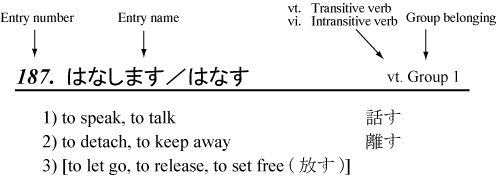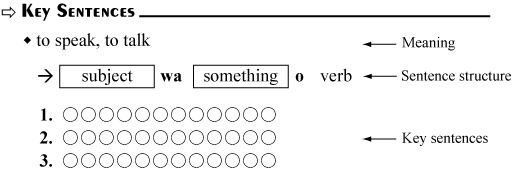Main Entries
Each entry name consists of the masu form and the root form (dictionary form).
Different verbs pronounced similarly are under the same entry name.
For example, as shown below, 1, 2 and 3 are different verbs, but because they are pronounced and conjugated similarly,
they are under the same entry name.
This material uses the Japanese Kana syllabary order for the entry numbers.
A Romaji index in alphabetical order is also provided.

The meanings of more advanced level verbs are enclosed in parentheses and no example sentences are given.
Verb Groupings
Japanese verbs can be classified in several ways.
Classification according to conjugation
Japanese verbs have inflection. They are classified into three groupings according to the way they are conjugated.
Verbs in the same group follow the same rule when making various verb forms (with some exception).
| Group 1 | : | most i-ending verbs (iki-masu, kaki-masu, ai-masu) |
| Group 2 | : | all e-ending verbs (tabe-masu, ake-masu, de-masu) |
| some i-ending verbs (mi-masu, i-masu, kari-masu) | ||
| Group 3 | : | two verbs; shimasu and kimasu (to come) |
Transitive verbs and intransitive verbs
Japanese transitive and intransitive verbs are written using the same Kanji but are read differently in many cases.
In this material, they are entered separately; "vt." is used to indicate transitive verb, "vi." for intransitive verb.
| ex. | kowashimasu | (vt.) |  |
Transitive verb |
| kowaremasu | (vi.) |  |
Intransitive verb |
Kodomo wa jitensha o kowashimashita.
My child broke a bicycle.
Jitensha wa kowaremashita.
A bicycle broke.
The two most important classifications in learning Japanese verbs, i.e. transitive or intransitive and group belonging, are indicated on the right of the entry name.
Verb conjugation
In this material, we pick up 17 verb conjugation forms.
To make each form, other than the masu form, there are certain rules which must be followed depending on which group a verb belongs to.
| masu form | masu form aff. | masu; masu form affirmative |
| masu form neg. | masen; masu form negative | |
| masu past aff. | mashita; masu form past affirmative | |
| masu past neg. | masendeshita; masu form past negative | |
| Plain form | root form | Plain form affirmative (dictionary form) |
| nai form | Plain form negative | |
| ta form | Plain form past affirmative | |
| nakatta form | Plain form past negative | |
| te form | te form | |
| conditional | Conditional form (ba form) | |
| potential | Potential form | |
| imperative | Imperative form | |
| volitional | Volitional form | |
| passive | Passive form | |
| causative | Causative form | |
| caus. passive 1 | Causative passive Long form | |
| caus. passive 2 | Causative passive Short form |
In the conjugation, some forms are enclosed in parentheses.
They are forms which could be mechanically made but in fact have no meaning or are never used.
The constitution of this material and the examples
The examples are divided into three sections.
1) Key Sentences

In order to master verbs, it is important to know their meanings but it is also important to understand the syntax of verbs.
In this section, we provide the basic sentence structure for each verb.
It shows how the verb is used. Example sentences are also presented in this section according to the structure.
Moreover, only the masu form and the te form are used in the example sentences so that even beginners who have not yet studied the conjugation of the pattern can easily understand the sentence structure.

"Something" is symbolic so it could be a thing, a company, an event, or even a person.
In the actual con-versation, the subject and the object could be omitted, and words and phrases are sometimes replaced with another,
so the sentences are not always in ac-cordance with the given sentence structure.
Even so, it is advisable for be-ginners to make sentences accordingly.
The following five patterns are the basic Japanese sentence structures.
| 1. | [subject] wa/ga [noun / adjective] desu |
| 2. | [subject] wa/ga [intransitive verb] |
| 3. | [subject] wa/ga [indirect object] ni [intransitive verb] |
| 4. | [subject] wa/ga [object] o [transitive verb] |
| 5. | [subject] wa/ga [indirect object] ni [object] o [transitive verb] |
Particles wa and ga
This material is not a grammar book so there is no explanation of particles.
Whether the subject is followed by the particles wa or ga depends on the context.
Therefore, it is not possible to determine that in the context of simple sentences like the examples given.
In the sentences, either wa or ga is used when it is thought to be generally appropriate.
2) Practical Usage

In this section, practical sentences are given as examples in accordance with sentence patterns often used with each of the verbs.
Since the patterns introduced here are frequently used in daily conversation, both the verbs and the patterns should be mastered.
3) Dialogue

Practical examples of everyday conversations which take place between friends, at work, etc. are provided.
The expressions used here are those which are actually used in conversation.
By changing the proper nouns, they can be used in real situations such as shopping and on trips.




